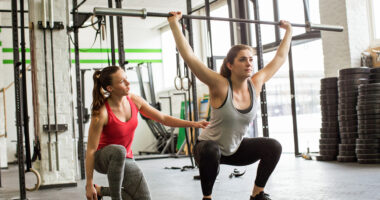Heres a list of some of the best barbell exercises for beginners that are easy to perform and can be easily modified for those who have limited time.
So how do you get started? It’s easy! Let’s say we have a beginner weightlifting lifter. The first thing they’ll need is a barbell. The next thing they’ll need is a good pair of shoes. Once you’ve got those two things, you can start lifting weights!
If you are new to barbell exercises, here are some exercises you can try at home. Barbell Exercises to Try for Beginners (I) Most of the exercises are done with two barbells instead of just one. Do the following exercises for 3 sets of 12 reps, but don’t go heavy. 1. Incline barbell bench press. 2. Dumbbell bench press. 3. Parallel barbell curl. 4. Dumbbell curl. 5. Barbell rows. 6. Dumbbell bent over rows. 7. One arm dumbbell row. 8. Lat pull down.. Read more about barbell workout routine at home and let us know what you think.
For many people, a barbell appears to be the most difficult piece of training equipment. A barbell is very different from kettlebells and dumbbells, unless you’ve already lifted them. It’s bigger and won’t fit in one hand. You won’t be able to move it around the body as quickly. Despite this, many people consider the barbell to be one of the most important pieces of home gym equipment for building and toning muscles.
Before moving on to barbells, you should surely master bodyweight exercises (or other weights, for this kind of matter). If you don’t have a strong foundation of stability and know how to perform simple exercises with strength training equipment, you can’t even try barbells.
There are a plethora of different ways to hold a barbell.
Depending on the workout, the targets, and the type of barbell utilized, there are a variety of ways to grip a barbell.
Pronated
The barbell deadlifts will be built on this palms-down hold, which is by far the most well-known manner of holding a barbell. It’s not the strongest grasp, but it limits the amount of weight you can hold during activities like strength training.
Supinated
This grip appears to be perfect for curls and rowing variations that reach the biceps with its palms up. It will not, however, work for the great majority of other barbell workouts.
Alternated
In this method, the barbell is held in one hand in a pronated grip and the other in a supinated grip.
Because this unequal grasp raises the danger of injuring the flexor tendon and shoulder, alternating how you place every other hand at each set will allow you to grip more weight than you could with a double-overhand hold. This would ensure that both arms are used in the same way.
Hook
This grip, which involves grasping the bar with simply a pronated grip and folding the fingers over the thumb, may help you hold heavy loads in deadlifts and rows, but it can be unpleasant for your thumbs. The most usual sightings are at weightlifting competitions. If at all possible, use it with caution.
Neutral
When clutching straight barbells with both hands, it’s difficult to keep the bar in place since the palms face away from the body, as they do with dumbbell workouts.
Fortunately, this would be employed in the trap/hex bars, making it a somewhat comfortable shoulder position for individuals with sore shoulders.
Exercise with a Barbell Back Squat
Unsplash photo by Sam Moqadam
Because there is no pain and no severe movement limits with the back squat, it should be a regular element of any weight lifter’s system. This barbell back squat workout would be suitable for a completely functional lower body, practical, but demanding. However, because it requires a lot of movement and steadiness, it might be difficult to learn at first.
Take a small plate (5–10 lbs.) directly beneath your heels if you find it difficult to squat down low and feel stuck, or if your torso starts to feel like it wants to fail forward. It aids in compensating for common ankle mobility issues.
This helps to explain why Olympic bodybuilders and other powerlifters wear athletic powerlifting shoes. A heel raise in the shoes allows the bodybuilder to squat lower. Additionally, working on ankle movement might help enhance the squat method.
With a barbell, do a front squat.
Unsplash photo by Sergio Pedemonte
The most major distinction between front and back squats is where the barbell is placed on your body. If you squat with the bar next to you, whether in a back squat or a front squat, you must take a more upright position, with your hips going straight down but your knees extending forward to a significant degree. The front squat targets the quadriceps and core at the same time.
In a back squat, the body is forced forward, causing the hips to push back and the knees to bend forward as well. Because the hips do the majority of the work, the back squat will assist align the glutes, hamstrings, and lower back.
The front squat is a little more difficult to perfect since it requires so much movement in the ankles and upper torso. However, two very distinct squats are excellent possibilities, and one isn’t necessarily better than the other, depending on the aim and objectives.
Using a Barbell to Bench Press
Pexels photo by Andrea Piacquadio
The bench press is a fantastic workout that strengthens the shoulders, chest, and triceps while also increasing overall pressing strength. The mid-back and lower body should all contribute significantly if done correctly.
In weightlifting, an arched body position is only appropriate when completing a barbell chest press.
Rows with a Bent-Over Position with a Barbell
Rows with a barbell for the lower back. Over time, it will correct your spinal posture.
The bent-over posture row is an excellent upper-back and middle-back workout. It can be tough to maintain a bent-over position, but if you can, you’ll be training the same muscles in your hamstrings, glutes, and lower back.
The bent-over position row is the most important motion, but you should devote the same amount of time to back training as you do to chest training. The barbell row is the only workout that targets all of the muscles that make up the back of the torso, which is crucial for developing strong core muscles.
The body movement necessitates not only a strong effect, but also the strength to stay in the bent-over posture row; this, of course, necessitates strong spinal glute muscles, which are plainly core workouts.
With a Few Changes to the Sumo Barbell Deadlift
Unsplash photo by Victor Freitas
It’s challenging to focus on the hips rather than bending over towards the lower back, and it’s considerably more difficult when the deadlift is accompanied by a weight. Rather of launching right into more common sumo or normal variants, the sumo deadlift was determined to be a beginner-friendly option.
This workout is a distant second to a squat in terms of utility. The key rationale for the lighter barbell is that it has a limited range of motion and does not necessitate lowering the barbell’s loads.
Many people could deadlift as much as they squat because of the severe leverage. A relatively small range of motion means less muscle action is needed, but it also means it won’t do as much to maintain and increase flexibility as wide range squat exercises do.
With a barbell, perform an overhead press.
Unsplash photo by Victor Freitas
The rigid barbell overhead press is one of the most difficult barbell workouts to master. A lot of shoulder mobility and core stability are required while lifting a weight overhead. As a result, beginners should begin with an angled barbell press.
By not attempting to press overhead, you eliminate several of the stability and mobility criteria. Even so, the triceps and shoulders are where you build the majority of your muscle strength and resilience.
An old-fashioned muscular test is lifting a large weight above one’s head. The barbell overhead press requires shoulder strength and stability, as well as strength and flexibility. This workout may help you develop huge delts and a strong back, as well as enhanced overhead resilience that will help you transition to a bench press.
When performing an overhead press with a barbell, keep in mind that the weight must pass through the head, upper spine, ankles, and hips before passing over the center of gravity. To keep the bar in line, squeeze the abdominal muscles, glutes, and move the head into when the bar has also passed the nose. To squeeze these glutes, maintain the core tight. This will boost the lift to roughly 10%.
With a barbell, perform a lunge press.
Pexels photo by Anete Lusina.
A lunge press with a barbell would be a terrific lower-body activity because it allows you to use huge weights with one leg in such a fluid action. The aforementioned workout has numerous versions that can be utilized to identify the glutes in the lower body. One of the most underestimated workouts for enhancing athletic performance is this one.
Using a Barbell to Perform Military Presses
Pexels photo by Victor Freitas
The military press with a barbell is by far the most workable upper-body workout a barbell can provide. It can also help to strengthen the arms and shoulders. My favourite application, though, is as a simple shoulder fitness check. If you can’t get through the upper position, you’ll need to work on your shoulders.
This workout requires getting overhead, which is an important range of motion for long-term shoulder fitness and injury prevention that many individuals overlook in their daily routines. The body operates primarily on the “do it or lose it” principle, which means that if you never reach your upper arms over your head, you have effectively lost the ability to use them.
It is beneficial for arm and shoulder strength. If you can’t get to the top position, it’s time to work on your shoulders.
Last Thoughts
Consider your physical strength before deciding whether or not to utilize barbells. By the time you want to go barbell, you should be quite familiar with the hinging, squatting, and pressing mechanics of the lift, bench, and squats, and you’ll be almost ready to start stacking them heavier.
If you’re new to the world of weight training, it can be a little intimidating to know where to start. Well, worry no more. While there are many exercises out there, the following five exercises are great for beginners, and can produce great results with just a little effort.. Read more about small barbell exercises and let us know what you think.
Frequently Asked Questions
How should a barbell workout for beginners?
A barbell workout is a great way to get in shape and build muscle. To start, you should find a weight that you can lift with your arms straight up above your head. This will be the weight that you use for all of your exercises.
What weight barbell should a beginner use?
A beginner should start with a barbell that is around 2.5-3kg.
What are the 3 basic barbell lifts?
The three basic barbell lifts are the squat, the deadlift, and the bench press.
Related Tags
This article broadly covered the following related topics:
- barbell exercises
- barbell exercises without bench
- best barbell exercises
- barbell workout routine at home
- barbell exercises pdf










